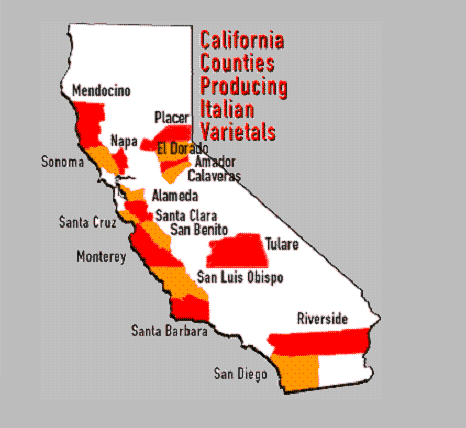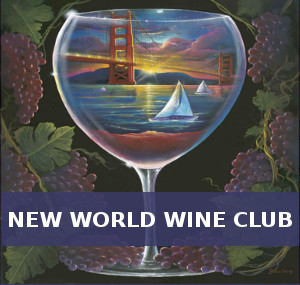In California, with all the Chardonnay, Cabernet, Pinot Noir, and Sauvignon Blanc out there, sometimes it’s easy to overlook the amount of variety in the state. In the past few years, in particular, I’ve notice several growers who have made quality strides with the Italian varietals they produce. Most of you are probably acquainted with Pinot Grigio and Sangiovese. Perhaps Nebbiolo, Barbera, and Pinot Blanc are somewhat familiar. Dolcetto and Arneis may not have crossed your wine radar. But they are all worth trying, especially if you’d like to broaden the scope of wine you enjoy. When grown in California, these grapes are able to hang on the vines longer, due to a more temperate climate, which allows for an extended growing season. This means, the grapes are often able to ripen further than they can in Italy. Thus, compared to their counterparts from across the pond, the wines made here are generally more fruit-driven. So, while fans of dry, earthy Italian reds and delicate, light Italian whites may not wish to convert, my guess is that, for many wine lovers, the Californian interpretations of the varietals will be friendlier and more approachable. There are Cal-Ital producers throughout the state, so for our round up, we simply couldn’t cover every region. Instead, we focused on a few wineries with a variety of offerings. Our hope was to provide as sense of what’s out there with a focused breadth (if that make sense).
You can read more about some of the varietals being produced below and if one peaks your interest, you can click over to our panel’s reviews.
Sangiovese
Sangiovese has proved successful in a wide range of California’s viticultural areas, producing medium-bodied wines with classic prune, cherry character aromatics and pleasant acidity. The variety was originally brought to California by pioneering Italian immigrants. It is surprising, however, that in an industry dominated by such names as Mondavi, Gallo, Trinchero, Martini, and Sebastiani, it wasn’t until the 1990s that this most illustrious of Italian grapes finally began to be planted with significant acreage in California.
Unlike most Italian Chianti, (in which Sangiovese is the main grape) the Californian winemakers will often give the wine a heavier dose of oak. This cuts down on the brightness of the wine and gives it a smoother, somewhat softer character. Because Sangiovese is fairly popular, there’s a good range available, from under $15 bargains to very elegant offers that run closer to the $50 range.
Girasole Vineyards 2009 Sangiovese, $10-15
Niner Estates 2007 Sangiovese, $25-30
Domenico 2005 La Famiglia Rosso (Sangiovese Blend), $25-30
Domenico 2005 Super Tuscan Style, $25-30
Mitchell Katz 2007 “Reversa” Sangiovese, $40-45
Hunt Cellars 2007 Rhapsody, $45-50
Pinot Grigio (aka. Pinot Gris)
Labeled either Pinot Grigio or Pinot Gris in North America, it is being grown more and more in California to counter the demand for Italian Pinot Grigio, and to court the increasing ABC (anything but Chardonnay) sentiments of wine consumers. Pinot Grigio in California can be more variable in style and quality than its northern counterparts, as the grapes have a tendency toward low acidity when subjected to warmer and more intense ripening conditions. A mutation of Pinot Noir, the grape can range in color from gray-blue to pink.
California’s take on the varietal isn’t vastly different than the Italians. Perhaps here, the wines are a bit rounder and not as dry, but there’s not a significant difference in the flavor profile.
Palmina 2010 Pinot Grigio, $15-20
Barra 2009 Pinot Grigio, $15-20
Nebbiolo
This black-skinned Italian variety is responsible for some of the best and longest lived red wines of Italy. However, despite the tremendous standing the Nebbiolo grape enjoys at home this native of the Piedmont region in northern Italy rarely triumphs abroad, or even outside of the Piedmont, for that matter.
Nebbiolo has yet to break into the mainstream as a varietal in North American vineyards. Notwithstanding, a handful of devout Italian varietalists in California’s Sierra Foothills and Central Coast appellations like Paso Robles and the Santa Ynez Valley, are proceeding with young plantings in anticipation of Nebbiolo’s rising to more fashionable status in the US marketplace.
Nebbiolo is heavier than Pinot Noir, but doesn’t have the same weight as a Cabernet. Therefore, it can pair nicely with dishes like lamb chops or chicken cacciatore. A finely crafted one can even be treasured on its own. We haven’t discovered that kind of quality in California just yet, but the producers are moving in a very positive direction.
Domenico 2006 Nebbiolo, $25-30
Barbera
Once one of the most widely planted of California’s red varietals, Barbera, a native of northern Italy’s Piedmont region, has all but vanished there as a varietal-labeled wine. While Barbera’s total acreage has dramatically declined in the best regions, it is still a stronghold blending grape for the ‘jug wines’ of the Central Valley. There, Barbera’s ability to retain high natural acidity is an important contribution to the rather soft and sluggish wines from this hot bulk wine area. Those few vinters still dabbling in varietal Barbera from moderate climates and coastal vineyards provide wine lovers with wonderful deeply-colored reds, with abundant fruit, lively acidity and refined tannins.
In general, California Barbera is not as bright and bold as those from Italy. The handful we tried were far richer and more refined, so if your personal preference is a softer, more elegant wine, you could be very happy with what these wineries have to offer.
Hunt Cellars 2009 Barbera (Barrel Sample)
Aglianico
Along with Sangiovese and Nebbiolo, Aglianico is considered one of Italy’s three noble grape varietals.The wines themselves are extremely high in both tannins and acidity. Often closed in youth, with time, Aglianico develops rich game, earth and dark fruit qualities.
The limited acreage devoted to the Aglianico grape in California is centered around Paso Robles and Amador County. However, given the renewed interest in Aglianico based wines in Italy, it should only be a matter of time before Cal-Ital producers begin to plant more significant acreage of this grape in the state.
Domenico 2005 Agianico, $25-30
Dolcetto
Dolcetto originates in the Piedmont region of Italy, where it is overshadowed by the more powerful and concentrated Nebbiolo and even Barbera. In California there are less than 100 acres under vine, typically grown by expatriate Italians. The grape produces deeply-pigmented wines, thick with fruit character, high in natural acidity and having only mild tannins. Dolcetto is best consumed young, as its youthful fruit character fades quicker than its acidity.
Naughty Boy Vineyards 2007 Dolcetto, $10-15
Domenico 2006 Dolcetto, $25-30
Arneis
Arneis is an ancient grape varietal native to Italy’s Piedmont region. It produces fragrant, white peach and pear scented white wines. A minor grape in California, some of the state’s most prolific Ital-centric wineries, including Pepi and Seghesio are now experimenting with Arneis.
Arneis, which translates to ‘little rascal’, can be a difficult grape in the vineyard. The variety is prone to low acidity when fully ripe. For this reason, in California Arneis seems to perform its best in cooler climate appellations that are reminiscent of the grapes Piedmont home in the foothills of the Italian Alps.
In California, this varietal tends to be a bit rounder than most Sauvignon Blancs and not as dry. In other words, its a nice mid-point between creamy Chardonnay and dry whites like Pinot Grigio.
Muscat Cannelli
Known by many names, this grape’s official French name is Muscat Blanc à Petits Grains, which translates as ‘Muscat with small berries’. In California, the name Muscat Canelli is common, derived from Moscato di Canelli, a name used in Italy.
In the northern hemisphere, this late-ripening variety is mainly used to make semi-sweet and sweet dessert wines, or as a table grape. Often floral, round and lush, they can be very pleasant summer wines.
Barra of Mendocino 2007 Muscat Canelli, $15-20
Pinot Blanc (aka. Pinot Bianco)
In California, Pinot Blanc is used mainly to produce bubbly bruts. Pinot Blanc’s rather neutral flavor and brisk natural acidity make it a popular choice for sparkling wines, not just in California, but also in France, No one will claim that this modest white variety is the noblest grape in the vineyard. But a few dedicated experimentalists haven’t given up on this humblest of Pinots. With a delicate balance between the grape’s natural tendencies and California’s ripening potential, they are revealing a very satisfying and more succulent side of Pinot Blanc. Its main claim to popularity is its uncomplicated, mildly-flavored wines, which can often be refreshingly tart from cool growing regions.
Girasole Vineyards 2009 Pinot Blanc, $10-15
By Jason Barlow












